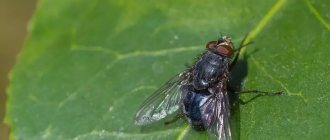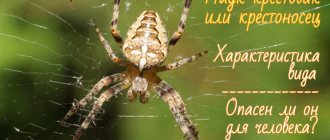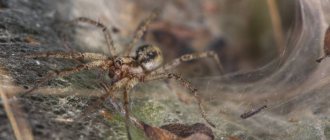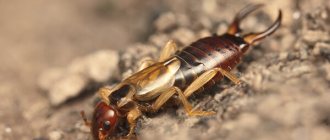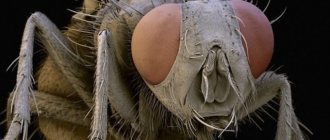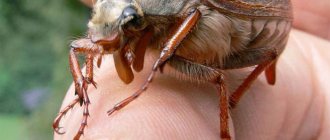Fly - description and characteristics
The body length of a fly can be from a few millimeters to 2 cm. The insect has a pair of membranous wings, a rather large head, endowed with an oral organ - a proboscis, designed for sucking up liquid food. The fly's body consists of three parts: head, abdomen and chest, ending with three pairs of legs. Each leg of a fly is divided into five segments. One part is the foot, with two sharp claws and sticky pads. This feature allows the fly to quickly move along the ceiling and any vertical surfaces.
The eyes of a fly are a unique organ. Thanks to several thousand hexagonal facets, the fly has a circular field of vision, so its huge eyes can easily simultaneously see everything that happens to the side and even behind. The organ of smell is the antennae, which can recognize odors at great distances.
Fly feeding
The fly is a magnificent acrobat. The flight of a fly can be compared to the flight of an ace pilot performing aerobatic maneuvers. She, like a helicopter, can take off and land without a run, spin in the air in one place, fly backwards. It is estimated that in one second a fly flaps its wings 200 times.
At the same time, the rear pair of wings, the halteres, help the fly maintain balance while performing any dizzying pirouette and avoid falling. Such acrobatics require a lot of energy. Therefore, the life of a fly is almost entirely, with the exception of the breeding season, devoted to the search for food.
The fly feeds on liquid food, sucking it through the proboscis mouth located in front of the head. She also has teeth, although they are very tiny, they are located on the same proboscis. Their main task is to separate food particles. Since solid food is not suitable for the fly, it first moistens it with liquid regurgitated through the proboscis.
The fly is not picky when it comes to food, it eats the same things as humans, and does not disdain various sewage and animal remains. However, the instinct of survival makes the fly be careful, so before starting a meal, it tastes the food with its foot to determine the composition and quality of the food. If you choose by the frequency of washing, a fly can claim the title of the cleanest animal, since they wash themselves almost constantly and incredibly quickly: up to 100 times per minute.
When you see a fly rubbing its legs together, it means that it is cleaning them, removing whatever has fallen on them, various debris. But how dangerous can this garbage be! These can be bacteria of typhoid, tuberculosis, dysentery. Flies collect these bacteria on various waste and sewage. On its legs and proboscis you can easily find more than 1 million dangerous bacteria.
Then, if they suddenly sit on our food, these bacteria will get into it and we can get an infection. Therefore, remember: Fly and man - contact is dangerous!
Types of flies, names and photographs
There are 3,650 species of flies in the world, some of which are particularly common:
- house fly
a gray insect native to the Asian steppes. Distributed everywhere, most often near human habitation. Externally, many species are similar to the house fly, but it is distinguished by a special break at the edge of the wings. Under favorable conditions, the insect can live up to 2 months;
Housefly
- hoverfly (syrphid)
in appearance and habits it is similar to a wasp. The insect is distinguished by a black and yellow striped body and transparent wings. The hoverfly feeds on the nectar of flowering plants and is absolutely harmless. The fly got its name from the murmuring sound made by its wings when hovering;
Hoverfly
- green (carrion) fly
An insect with a shiny emerald body that lives near sewage and carrion. To avoid being eaten after mating, the male fly first offers the female some food;
Carrion fly
- common milkweed (tenacious) or bee-shaped milkweed
considered a subspecies of hover flies. A large insect, up to 1.5 cm long, with a dark-colored body covered with hairy pubescence. Beeworm larvae that enter the human body can cause serious intestinal disorders;
Ilnitsa vulgare
- ktyr
a large predatory fly that poses a danger to mosquitoes, midges, bees, and also similar flies. Killing various dangerous insects with a sharp sting and poison, tyri flies bring significant benefits to humanity;
Fly ktyr
- Tsetse fly
inhabitant of the African continent. The main source of nutrition for this dangerous predator is the blood of wild mammals, as well as livestock and people. Tsetse flies are carriers of trypanosomes, which cause an incurable disease that destroys the immune and nervous systems and leads to death.
Tsetse fly. Alan R Walker, CC BY-SA 3.0
Fly research
And yet, like a fly, he walks on the ceiling. This question is asked not only by lazy people lying on the couch and looking at the ceiling, but also by scientists from many countries around the world.
After a survey of the children in our class, 56% said that on the legs of a fly there are hairs with small hooks with which the fly clings to the surface, 34% are sure that the suction cups on the fly’s legs help it move freely along the ceiling, and 10% could not give an answer to this question.
Diagram No. 1 Why don't flies fall from the ceiling?
Under the guidance of the teacher, using a Levenhuk microscope, the guys and I did a little research work. You need to put the specimen with the fly leg under a microscope at low magnification and adjust the sharpness. This is what we saw.
There were indeed hairs on the fly's leg, but we did not find any hooks on them.
At the end of the paw we saw small claws that did not look like suction cups at all.
Thus, none of the guys’ statements were confirmed. I had to turn again to the scientific literature. It turned out that the fly walks on two claws (we saw them), located on the lower part of the foot. The sticky pads under these claws allow the fly to walk upside down on the ceiling or anywhere else with great ease!
Conclusion
In the course of our work, we became convinced that the fly, this annoying, harmful creature that carries all kinds of infection, can actually be a very interesting creature. Just like any other animal on Earth, if you look closely at it.
What do flies eat?
Flies are omnivorous insects and can feed on any organic food. The flies pre-soak solid food with saliva. Sweet liquids and foods are especially preferred. Some types of flies are true “gourmets” and eat exclusively onions or carrots. Pyophyllides (cheese flies) reproduce only inside the head of cheese.
Internal structure
The characteristics of the insect include its internal structure. Many people are interested in how a fly breathes and whether it can think. To answer questions like these, you need to consider:
- digestive system;
- reproductive system;
- other organs.
Reproductive system
The genital organs are located in the abdomen. Like other living creatures, they consist of ducts, accessory glands, eggs or testes, depending on the gender of the insect.
External appendages vary depending on the species of Diptera. Flies lay from 60 to 160 eggs. Some species of winged pests are viviparous. They give birth to maggots.
Digestive system
The abdomen contains most of the digestive organs:
- water tubules;
- intestines;
- goiter.
In fact, the insect lacks a digestive organ. Food is digested before it enters the abdomen. The insect secretes secretions while absorbing food. She digests the “food”.
Other organs
Insects do not have such complex systems as humans. The brain helps coordinate movement. In this case, an organ such as the reflex arc is responsible for reflexes. The brain contains several thousand neurons.
Important: the fly has no intelligence and memory only retains information for the last 3 seconds.
The insect's body contains 10 pairs of spiracles that allow the pest to breathe. Oxygen enters each organ through its own spiracle.
Reproduction of flies
With the exception of some viviparous species, most flies lay eggs. Males attract females with a low buzzing sound. 2-3 days after mating, the female fly is ready to lay eggs in any food or organic waste.
One clutch contains approximately 150 eggs. During its existence, a female fly can lay up to 3 thousand eggs. After a day, fly larvae and maggots appear.
This stage of development lasts about a week, during which time the larva increases in size up to 800 times.
The larval stage enters pupation and continues for another week. An adult fly, which does not change its size throughout its life, is born 12-14 days after laying eggs.
For the first 2-3 days, until the wings become stronger, the insect can only crawl. The average lifespan of a fly is 3 weeks.
Eyes of a fly
The most common species is the housefly . Catch a fly and look into its eyes. They attract attention by their size - they occupy almost the entire area of the head. The eyes of a fly cannot be called simple. Each of them consists of at least two thousand facets of miniature eyes.
The housefly has 4,000 of them in each eye. When a fly looks at a flower, each facet sees a tiny part of the flower, and the brain connects thousands of pieces—picture puzzles—into one overall image of the flower. This technique allowed scientists to create a device for accurately determining the speed of supersonic aircraft; It was called that way - “the eye of a fly.”
On the insect's head there are many bristles sticking up, we can say that this is the insect's natural signaling system. Due to their high sensitivity to various types of vibrations, the bristles promptly warn of impending danger.
Characteristics of flies
Flies are carriers of pathogenic bacteria and dangerous infections. Fly larvae are capable of parasitizing any living organism, be it an animal or a human. Despite this, the familiar, annoying insect is an integral component of the biosphere and deserves every right to exist.
However, a fly is not always just dirt and unsanitary conditions. Some types of flies and their larvae are food for animals, while other types pollinate plants. Scientists have proven that the fly is endowed with a rare gene code with increased immunity that recognizes and destroys harmful cells. The discovery provides a chance to save humanity from many terrible diseases.
Variety of flies
According to people, flies are the most annoying and ubiquitous insects. They easily penetrate homes, where they crawl all over everything. But nature actually loves flies. There are more than 750 thousand varieties of these insects on the planet and this is not the limit. Scientific expeditions regularly find new species of flies in remote places.
The tsetse fly has long been recognized as the most dangerous fly . These biting insects infect people and animals with an incurable disease. The tsetse fly attacks any warm object, even a pot of stew. But he never attacks a zebra. The alternation of dark and light stripes somehow scares away a dangerous insect.
Calliphorid fly larvae are used in medicine - sterile, laboratory-grown larvae eat dead tissue, cleaning and disinfecting the wounds of patients.
And during the mating season, pusher flies dance in the air, choosing a mate. The female agrees to accept the male only in exchange for a gift - a fly wrapped in a package - a silk ball, which the male makes himself. If he doesn’t like the gift, the male runs the risk of becoming a snack.
Interesting facts about flies
Despite the obvious harm and potential danger, flies are considered quite interesting insects:
- Since ancient times, some healers have used fly larvae to treat neglected wounds, using their ability to eat away dead tissue;
- flies were especially favored by the ancient Egyptians: the insect was considered a symbol of audacity and courage;
- The voracious larvae of hoverflies eat over 2 thousand aphids during their development.
Did you like the article? Share with your friends:
